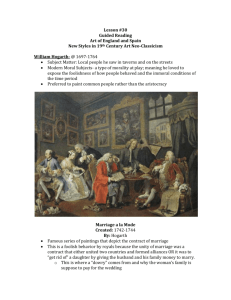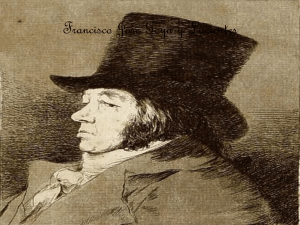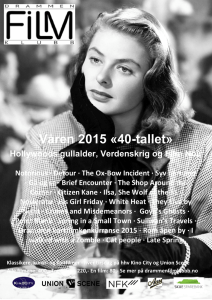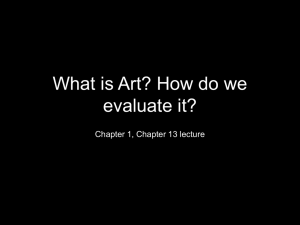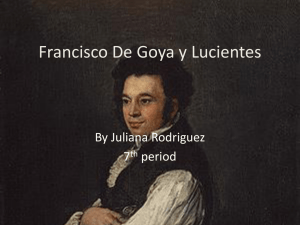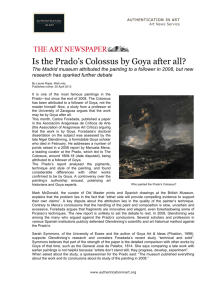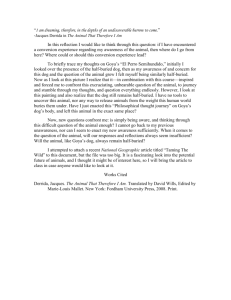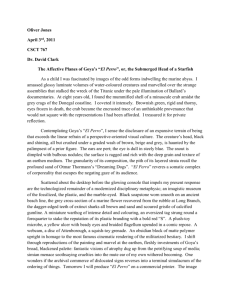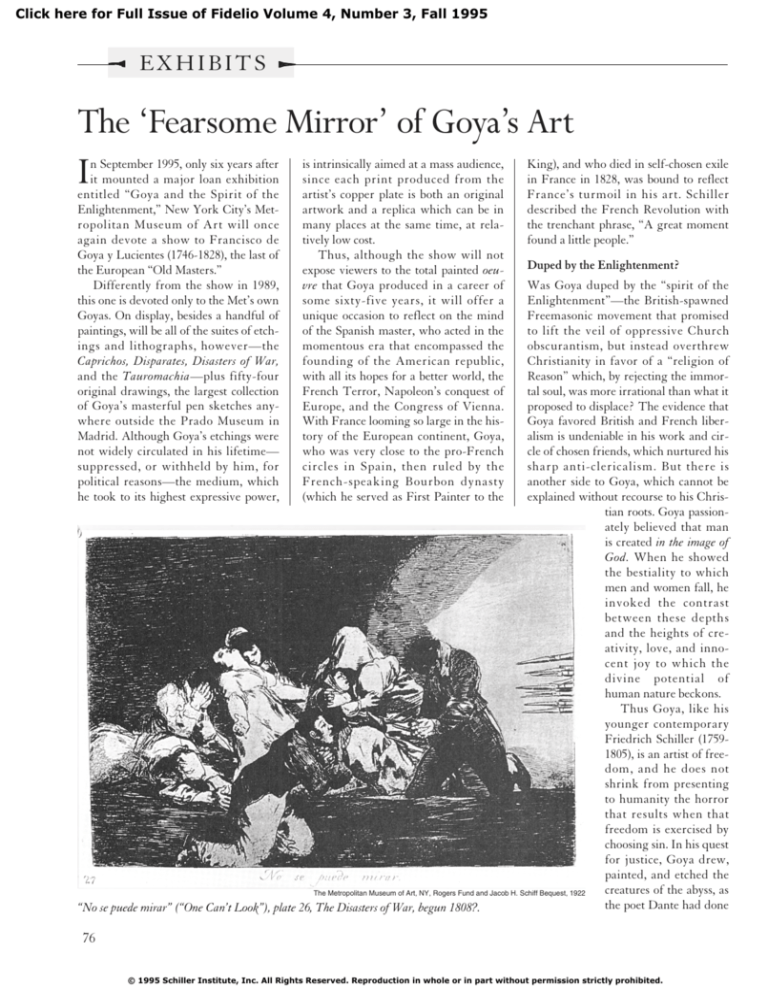
Click here for Full Issue of Fidelio Volume 4, Number 3, Fall 1995
EX H IB IT S
The ‘Fearsome Mirror’ of Goya’s Art
I
n September 1995, only six years after
it mounted a major loan exhibition
entitled “Goya and the Spirit of the
Enlightenment,” New York City’s Metropolitan Museum of Art will once
again devote a show to Francisco de
Goya y Lucientes (1746-1828), the last of
the European “Old Masters.”
Differently from the show in 1989,
this one is devoted only to the Met’s own
Goyas. On display, besides a handful of
paintings, will be all of the suites of etchings and lithographs, however—the
Caprichos, Disparates, Disasters of War,
and the Tauromachia—plus fifty-four
original drawings, the largest collection
of Goya’s masterful pen sketches anywhere outside the Prado Museum in
Madrid. Although Goya’s etchings were
not widely circulated in his lifetime—
suppressed, or withheld by him, for
political reasons—the medium, which
he took to its highest expressive power,
is intrinsically aimed at a mass audience,
since each print produced from the
artist’s copper plate is both an original
artwork and a replica which can be in
many places at the same time, at relatively low cost.
Thus, although the show will not
expose viewers to the total painted oeuvre that Goya produced in a career of
some sixty-five years, it will offer a
unique occasion to reflect on the mind
of the Spanish master, who acted in the
momentous era that encompassed the
founding of the American republic,
with all its hopes for a better world, the
French Terror, Napoleon’s conquest of
Europe, and the Congress of Vienna.
With France looming so large in the history of the European continent, Goya,
who was very close to the pro-French
circles in Spain, then ruled by the
French-speaking Bourbon dynasty
(which he served as First Painter to the
King), and who died in self-chosen exile
in France in 1828, was bound to reflect
France’s turmoil in his art. Schiller
described the French Revolution with
the trenchant phrase, “A great moment
found a little people.”
Duped by the Enlightenment?
Was Goya duped by the “spirit of the
Enlightenment”—the British-spawned
Freemasonic movement that promised
to lift the veil of oppressive Church
obscurantism, but instead overthrew
Christianity in favor of a “religion of
Reason” which, by rejecting the immortal soul, was more irrational than what it
proposed to displace? The evidence that
Goya favored British and French liberalism is undeniable in his work and circle of chosen friends, which nurtured his
sharp anti-clericalism. But there is
another side to Goya, which cannot be
explained without recourse to his Christian roots. Goya passionately believed that man
is created in the image of
God. When he showed
the bestiality to which
men and women fall, he
invoked the contrast
between these depths
and the heights of creativity, love, and innocent joy to which the
divine potential of
human nature beckons.
Thus Goya, like his
younger contemporary
Friedrich Schiller (17591805), is an artist of freedom, and he does not
shrink from presenting
to humanity the horror
that results when that
freedom is exercised by
choosing sin. In his quest
for justice, Goya drew,
painted, and etched the
creatures of the abyss, as
The Metropolitan Museum of Art, NY, Rogers Fund and Jacob H. Schiff Bequest, 1922
the poet Dante had done
“No se puede mirar” (“One Can’t Look”), plate 26, The Disasters of War, begun 1808?.
76
© 1995 Schiller Institute, Inc. All Rights Reserved. Reproduction in whole or in part without permission strictly prohibited.
The Met’s Portraits
The Met’s collection of Goya paintings
has a checkered history. Many pictures
which entered the collection as Goya,
were soon revealed to be spurious. Now
even the popular “Majas on the Balcony”
has been rejected by scholars (it will be
exhibited side by side with the painting
believed to be Goya’s original). This
leaves a rather narrow gamut of the
painted oeuvre—omitting history, genre
scenes, and religious works—and
focussing on portraits. But the Met’s
Goya portraits are treasures. One of the
first is the famous “Little Boy in Red” of
c.1788, actually “Don Manuel Osorio de
Zuñiga,” the four-year-old son of the
Count of Altamira (the Met will also
exhibit the Lehman Collection’s “Countess of Altamira and her Daughter”).
Goya shows Manuel as gentle and
innocent, while the cats in the background are clearly waiting for their
chance to pounce on the magpie. (The
scene has religious overtones: Cats symbolized lust and witchcraft in Eighteenth-century Spain; birds in Christian
art have always been a metaphor for the
soul.) This depiction inverts the allusions which the British Eighteenth-century satirical artist Hogarth made to
children’s cruelty to animals. In fact,
Goya’s portraits of children are invariably tender; the problem for Goya was
not an evil innate in man, but the corruption of innocence through ignorance
and bestiality.
From 1792 comes another of Goya’s
greatest portraits: “Sebastián Martínez,” a
wealthy merchant
and art collector of
Cadiz, his intelligent personality
presented in a boldly informal pose
and simple, radiant
colors. This was a
critical period of
Goya’s life. While
in Cadiz, he was
stricken by a devastating illness.
He could not travel
home, and he remained there, recovering slowly in
Martínez’s house.
The illness left
Goya totally deaf,
and for the rest of
his life he suffered
from
tinnitus,
which left him not
only isolated by his
deafness, but tormented by constant
noise and ringing in
his ears. The personal suffering was
matched by the
tragedy of the fail- “El sueño de la razon produce monstruos” (“The Sleep of Reason
ure of the French Produces Monsters”), plate 43, Los Caprichos, first edition 1799.
Revolution, and its
when the U.S. Declaration of Indepeninversion into what Goya later called “the
dence proclaimed “life, liberty, and the
Sleep of Reason,” because 1792 marked
pursuit of happiness” to be the inalienthe outbreak of the Reign of Terror in
able right of all human beings. With
Paris.
respect to the great Vienna school of
Finally, from Goya’s later period,
music, he was a generation older than
after 1800, comes the Met’s portrait of
Beethoven, a few years Mozart’s senior,
his architect friend “Don Tiburcio
and half a generation younger than
Pérez.” It has even greater directness
Haydn, born in 1732.
than the Sebastián Martínez, and now,
Was Goya acquainted with any of
the wig of the Ancien Régime is off, and
these men’s works? We can say for sure
we are face to face with a cheerful, vigthat he knew of Haydn, then the most
orous man, with sleeves rolled up for
famous composer in Spain, whose
work.
“Seven Last Words of Christ on the
No False Gods
Cross” had been commissioned by the
Cadiz cathedral chapter in 1787, and
How may we do justice to Goya, an
whose scores appear in at least two Goya
artist who worked as a contemporary to
portraits.
many of the world’s greatest cultural
In painting, Goya’s exact contempooptimists? His 82 years paralleled the
rary is the French classicist Jacqueslifetime of Goethe, and encompassed the
Louis David (1748-1825), who was sucentire lifespans of Schiller, Beethoven,
cessively the painter to the French Revand Mozart. Born in 1746, he was thirty
The Metropolitan Museum of Art, NY, Bequest of Grace M. Pugh, 1985
in his portrayal of the Inferno. And, as
in Dante, these are not only hideous, but
often, funny beyond description.
Although Goya influenced every
important artist who came after him,
from Courbet to Manet, to Daumier, to
Picasso (to name only a few famous
ones), none of those who followed saw
human beings as souls to be redeemed.
And also, of course, none of them could
match his technique as a painter, for
Goya paints scenes of horror with
exquisite delicacy and sensuousness. The
beauty reaches into our hearts and
changes us even as the subject matter
stirs moral outrage.
77
The Metropolitan Museum of Art, NY, Gift of M. Knoedler & Co., 1918
omnipotent call, to relive their
olution, the Terror, and
shameful lives for the grim
Napoleon, and who also died
edification of later generain exile—David left France
tions. Unconsciously, like
after the Restoration, whereas
empty shadows, the horrors of
Goya fled there. It is David,
their own age pass before our
the ideologue of the Enlighteyes while we, horrified yet
enment, who most clearly
fascinated, curse their memoreveals that Goya was not
ry. . . . As surely as visual
that. Visitors to the Metropolrepresentation is more comitan should contrast the
pelling than the mute word or
rhetorical painting by David
cold exposition, it is equally
in that museum, “The Death
certain that the theater wields
of Socrates,” with the wickeda more profound, more lastly foolish mobs (the sort of
ing influence, than either
“democracy” that killed
morality or laws. . . .
Socrates) shown in Goya’s
“In the theater’s fearsome
etchings. The David picture,
mirror, the vices are shown to
dating from 1787, was a
be as loathsome as virtue is
broadside for the coming
lovely. . . .
Revolution, portraying So“With each day I grow
crates as the founder of the
older, my catalogue of villains
“religion of Reason,” substigrows shorter, and my index
tuting for Christ (in the paintof fools longer and more
ing, Socrates even has twelve
complete. If the entire moral
disciples). After beheading
guilt of the one species of perthe King of France, the
son stems from one and the
epigones of this religion (one
same source; if all the monwhich the historical Socrates
strous extremes of vice which
would not have recognized!)
have ever branded him, are
were by 1792-93 merrily exe“Asta su abuelo” (“And So Was His Grandfather”), plate 39, Los
merely altered forms, higher
cuting scientists. After 1800,
Caprichos, first edition 1799.
grades of a quality which, in
they brought their atrocities
joy manifested in the universal brotherthe end, we can all laugh about and
to Spain with the Napoleonic invasion.
hood of mankind?
love—why, then, would nature have
A painting exalting the founding of a
taken some different route with the
“religion of Reason” is unthinkable
More Fools Than Villains
other species? I know of only one secret
from Goya’s hand. For Goya—one of
Friedrich Schiller, who wrote the “Ode
for guarding man against depravity,
whose most moving late paintings is the
to Joy” set in the Ninth Symphony,
and that is: to arm his heart against
“Last Communion of St. Joseph
offers a guide in his 1784 essay on the
weaknesses. . . .
Calasanzo,” which he donated to a
“The stage holds up a mirror to that
“Theater as a Moral Institution.” We
church in Madrid—was seeking a
most populous class, the fools, and
need only replace the words “stage” or
reform of Christianity, purged of folly
exposes their thousand varieties to relief“theater” by “painting” and “etching,” to
and violence, and not its replacement by
bringing ridicule. . . . Man’s pride is
cast a bright light on the achievement of
a synthetic cult.
more deeply wounded by ridicule and
Goya’s late prints:
Had Goya died in 1797, we might
contempt, than his conscience is tor“The jurisdiction of the stage begins
know him only as a gifted rococo artist
mented by abhorrence. . . .
where the domain of secular law leaves
of the Venetian school, and a poignantly
“The stage also teaches us to be more
off. Whenever justice is dazzled by gold
truthful portraitist. What imprints on
just toward the victim of misfortune,
and gloats in the pay of infamy; when
future generations his Socratic genius, is
and to judge him more leniently. For,
what he did after the age of fifty, reprethe crimes of the mighty mock their
only once we can plumb the depths of
sented in this exhibit particularly by the
own impotence, and mortal fear stays
his tormented soul, are we entitled to
etchings starting with the Caprichos of
the ruler’s arm—then the theater takes
pass judgment on him.”
c.1800. We may ask, how these works,
up the sword and scales, and hauls
In fashioning such a “fearsome mirso often dark in mood, match up to
infamy before the dreadful tribune of
ror” for the education of mankind, the
challenge of the late Beethoven in his
justice. The entire realm of fantasy and
Spaniard Francesco de Goya knows no
opera Fidelio, his late string quartets, his
history, past and present, stands at its
equal.
Missa Solemnis, or his Ninth Symphobeck and call. Monstrous criminals, long
ny, which celebrated the divine spark of
rotted to dust, are summoned by poesy’s
—Nora Hamerman
78

